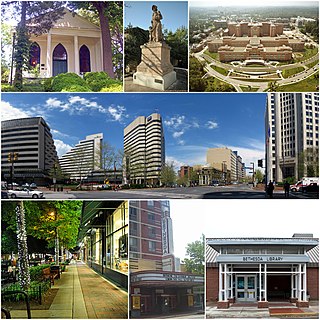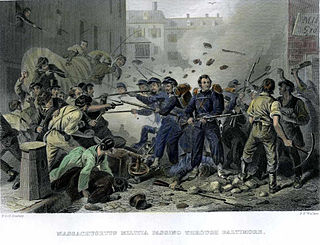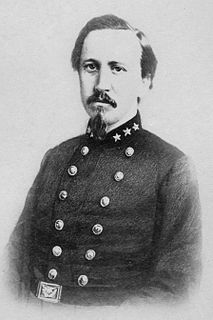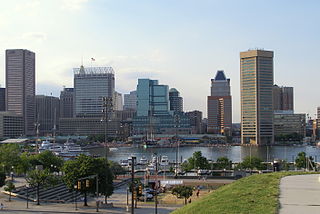
Maryland is a state in the Mid-Atlantic region of the United States. It shares borders with Virginia, West Virginia, and the District of Columbia to its south and west; Pennsylvania to its north; and Delaware and the Atlantic Ocean to its east. Baltimore is the largest city in the state, and the capital is Annapolis. Among its occasional nicknames are Old Line State, the Free State, and the Chesapeake Bay State. It is named after the English Queen Henrietta Maria, then known in England as Mary.

Bethesda is an unincorporated, census-designated place in southern Montgomery County, Maryland, United States, located just northwest of Washington, D.C. It takes its name from a local church, the Bethesda Meeting House, which in turn took its name from Jerusalem's Pool of Bethesda. The National Institutes of Health's main campus and the Walter Reed National Military Medical Center are in Bethesda, in addition to a number of corporate and government headquarters.

Calvert County is located in the U.S. state of Maryland. As of the 2010 census, the population was 88,737. Its county seat is Prince Frederick. The county's name is derived from the family name of the Barons of Baltimore, the proprietors of the English Colony of Maryland.

Frederick is a city in and the county seat of Frederick County, Maryland. It is part of the Baltimore–Washington Metropolitan Area. Frederick has long since been an important crossroads, located at the intersection of a major north–south Native American trail and east–west routes to the Chesapeake Bay, both at Baltimore and what became Washington, D.C. and across the Appalachian mountains to the Ohio River watershed. It is a part of the Washington-Arlington-Alexandria, DC-VA-MD-WV Metropolitan Statistical Area, which is part of a greater Washington-Baltimore-Arlington, DC-MD-VA-WV-PA Combined Statistical Area. The city's population was 78,171 people as of the 2020 United States census, making it the second-largest incorporated city in Maryland. Frederick is home to Frederick Municipal Airport, which accommodates general aviation, and Fort Detrick, a U.S. Army bioscience/communications research installation and Frederick county's largest employer.

Annapolis is the capital city of the U.S. state of Maryland as well as the county seat of, and only incorporated city in, Anne Arundel County. Situated on the Chesapeake Bay at the mouth of the Severn River, 25 miles (40 km) south of Baltimore and about 30 miles (50 km) east of Washington, D.C., Annapolis forms part of the Baltimore–Washington metropolitan area. The 2020 census recorded its population as 40,812, an increase of 6.3% since 2010.

Carroll County is located in the U.S. state of Maryland. As of the 2020 census, the population was 172,891. Its county seat is Westminster.

The Preakness Stakes is an American thoroughbred horse race held on Armed Forces Day which is also the third Saturday in May each year at Pimlico Race Course in Baltimore, Maryland. It is a Grade I race run over a distance of 9.5 furlongs on dirt. Colts and geldings carry 126 pounds (57 kg); fillies 121 pounds (55 kg). It is the second jewel of the Triple Crown, held two weeks after the Kentucky Derby and three weeks before the Belmont Stakes.

The Mason–Dixon line, also called the Mason and Dixon line or Mason's and Dixon's line, is a demarcation line separating four U.S. states, forming part of the borders of Pennsylvania, Maryland, Delaware, and West Virginia. Historically, it came to be seen as demarcating the North from the South in the U.S. It was surveyed between 1763 and 1767 by Charles Mason and Jeremiah Dixon in the resolution of a border dispute involving Maryland, Pennsylvania, and Delaware in Colonial America. The dispute had its origins almost a century earlier in the somewhat confusing proprietary grants by King Charles I to Lord Baltimore (Maryland) and by King Charles II to William Penn.

The Baltimore and Ohio Railroad was the first common carrier railroad and the oldest railroad in the United States, with its first section opening in 1830. Merchants from Baltimore, which had benefited to some extent from the construction of the National Road early in the century, wanted to do business with settlers crossing the Appalachian Mountains. The railroad faced competition from several existing and proposed enterprises, including the Albany-Schenectady Turnpike, built in 1797, the Erie Canal, which opened in 1825, and the Chesapeake and Ohio Canal. At first, the B&O was located entirely in the state of Maryland; its original line extending from the port of Baltimore west to Sandy Hook, Maryland, opened in 1834. There it connected with Harper's Ferry, first by boat, then by the Wager Bridge, across the Potomac River into Virginia, and also with the navigable Shenandoah River.

The Baltimore riot of 1861 was a civil conflict on Friday, April 19, 1861, on Pratt Street, in Baltimore, Maryland. It occurred between antiwar "Copperhead" Democrats and other Southern/Confederate sympathizers on one side, and on the other, members of Massachusetts and Pennsylvania state militia regiments en route to the national capital at Washington who had been called up for federal service. The fighting began at the President Street Station, spreading throughout President Street and subsequently to Howard Street, where it ended at the Camden Street Station. The riot produced the first deaths by hostile action in the American Civil War and is often called the "first bloodshed of the Civil War".

The Battle of Baltimore was a sea/land battle fought between British invaders and American defenders in the War of 1812. American forces repulsed sea and land invasions off the busy port city of Baltimore, Maryland, and killed the commander of the invading British forces. The British and Americans first met at the Battle of North Point. Though the Americans retreated, the battle was a successful delaying action that inflicted heavy casualties on the British, halted their advance, and consequently allowed the defenders at Baltimore to prepare for an attack properly.

The recorded history of Maryland dates back to the beginning of European exploration, starting with the Venetian John Cabot, who explored the coast of North America for the Kingdom of England in 1498. After European settlements had been made to the south and north, the colonial Province of Maryland was granted by King Charles I to Sir George Calvert (1579–1632), his former Secretary of State in 1632, for settlement beginning in March 1634. It was notable for having been established with religious freedom for Roman Catholics, since Calvert had publicly converted to that faith. Like other colonies and settlements of the Chesapeake Bay region, its economy was soon based on tobacco as a commodity crop, highly prized among the English, cultivated primarily by African slave labor, although many young people came from Britain sent as indentured servants or criminal prisoners in the early years.

During the American Civil War (1861–1865), Maryland, a slave state, was one of the border states, straddling the South and North. Despite some popular support for the cause of the Confederate States of America, Maryland did not secede during the Civil War. Because the state bordered the District of Columbia and the strong desire of the opposing factions within the state to sway public opinion towards their respective causes, Maryland played an important role in the war. Newly elected 16th President Abraham Lincoln, suspended the constitutional right of habeas corpus from Washington DC to Philadelphia, PA; and he dismissed Chief Justice Roger B. Taney of the U.S. Supreme Court's "Ex parte Merryman" decision in 1861 concerning freeing John Merryman, a prominent Southern sympathizer from Baltimore County arrested by the military and held in Fort McHenry. The Chief Justice had held that the suspension was unconstitutional and could only be done by Congress and would leave lasting civil and legal scars. The decision was filed in the U.S. Circuit Court for Maryland by Chief Justice Roger Brooke Taney, a Marylander from Frederick and former member of the administration of the seventh President Andrew Jackson, who had nominated him two decades earlier.

The Maryland Army National Guard is the United States Army component of the U.S. state of Maryland. It is headquartered at the old Fifth Regiment Armory at the intersection of North Howard Street, 29th Division Street, near Martin Luther King, Jr. Boulevard in Baltimore and has additional units assigned and quartered at several regional armories, bases/camps and other facilities across the state.

Bradley Tyler Johnson was an American lawyer, soldier, and writer. Although his home state of Maryland remained in the Union during the American Civil War, Johnson owned and traded slaves, and accordingly served as a brigadier general in the Confederate States Army, leading efforts to raise a Maryland Line in the CSA, and rising to command the 1st Maryland Infantry, CSA.

The following outline is provided as an overview of and topical guide to the U.S. state of Maryland:

Dixie, also known as Dixieland or Dixie's Land, is a nickname for the Southern United States that garnered popularity in the years during and after the American Civil War. While there is no official definition of this region, or the extent of the area it covers, most definitions include the U.S. states below the Mason–Dixon line that seceded and comprised the Confederate States of America, almost always including the Deep South. The term became popularized throughout the United States by its usage in songs nostalgically referencing the American South during the 20th century.

Baltimore is the most populous city in the U.S. state of Maryland, fourth most populous city in the Mid-Atlantic, as well as the 30th most populous city in the United States, with a population of 585,708 in 2020. Baltimore was designated an independent city by the Constitution of Maryland in 1851, and today is the most populous independent city in the United States. As of 2021, the population of the Baltimore metropolitan area was estimated to be 2,838,327, making it the 20th largest metropolitan area in the country. Baltimore is located about 40 miles (64 km) northeast of Washington, D.C., making it a principal city in the Washington–Baltimore combined statistical area (CSA), the fourth-largest CSA in the nation, with a calculated 2021 population of 9,946,526.

The 1st Maryland Infantry, CSA was a regiment of the Confederate army, formed shortly after the commencement of the American Civil War in April 1861. The unit was made up of volunteers from Maryland who, despite their home state remaining in the Union during the war, chose instead to fight for the Confederacy. The regiment saw action at the First Battle of Manassas, in the Shenandoah Valley Campaign, and in the Peninsular Campaign. It was mustered out of service in August 1862, its initial term of duty having expired. Many of its members, unable or unwilling to return to Union-occupied Maryland, went on to join a new regiment, the 2nd Maryland Infantry, CSA, which was formed in its place.

Fountain Hughes (ca. 1859 – 1957 was an American former slave freed in 1865 after the American Civil War. Born in Charlottesville, Virginia, he worked as a laborer for most of his life, moving in 1881 from Virginia to Baltimore, Maryland. He was interviewed in June 1949 about his life by the Library of Congress as part of the Federal Writers' Project of former slaves' oral histories. The recorded interview is online through the Library of Congress and the World Digital Library.

















